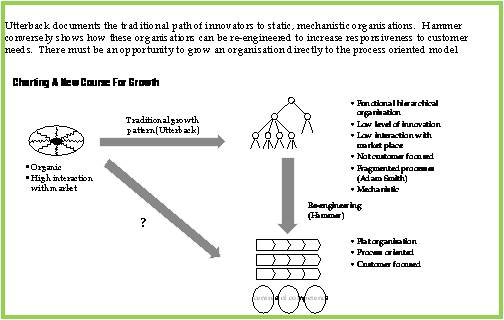In his seminal book “Mastering the Dynamics of Innovation”, James Utterback described the seemingly inevitable process by which young, thrusting innovative organisations become sclerotic. In particular, they are typified by:
- Mechanistic, functional hierarchical organisation
- Low level of innovation
- Low interaction with market place
- Not customer focused
- Fragmented processes (following Adam Smith and functional specialisation)
By happy coincidence, whilst reading Utterback, I was also reading Hammer & Champy, “Reengineering the Corporation”, which describes the consultants approach to taking these sclerotic old companies, and revitalising them and getting them fit for the 1990’s… The new pattern was a mix of process-orientation, supported by coaching from centres of competence.
As we now know with hindsight, this model is itself flawed, but it did offer a solution to the dead-hand of Adam Smith, and functional specialism, killing off innovation.
Here is the chart I drew for myself when I was originally puzzling through this conundrum…
Of course, the next question is (with 10 years hindsight), what should be the shape of organisations for the 21st and 22nd century?
